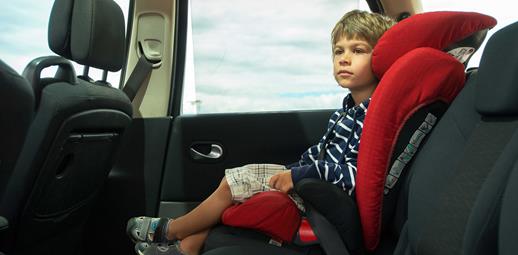
Knowing what type of car seat your child needs, and when, can be tricky, even though it’s hugely important for their safety.
If you have young kids who are using a seat with a harness, it’s essential to know when they’re big enough to take the next step and use a booster seat.
What is a booster seat?
Boosters raise the child's seating position so that you can use the car's seat belt to secure them.
These seats can be high-backed or simply cushions without a back at all.
When should I switch my child to a booster seat?
If you’re at the point where you’re considering a booster seat for your child, you’re probably well-versed on the different - sometimes overlapping - car seat groups. If you’re unsure or need a reminder, see our article on choosing the right car seat.
In a nutshell, your child is ready for a group 2 or group 3 high-backed booster seat once they’ve outgrown group 1 forward-facing seats, which are designed for infants who weigh 9-18kg.
The rules are a little different for one subgroup of boosters: cushions and booster seats with removable backs that can be removed. A change in the law in 2017 means that only children weighing over 22kg (3st 7lbs), who are also over 125cm (4ft 1ins) tall, are allowed to use these seats. The only exception to this is using existing booster seats or cushions that were already in use before the 2017 rule change; these are still permitted.
What type of booster seat should I choose?
Backless booster seats are convenient and cheap, costing as little as £6, according to research by Which?[1]. But there are concerns about the level of safety they provide.
The Royal Society for the Prevention of Accidents (RoSPA) explains: “The lack of a back and side wings removes any side and head protection from the child car seat, leaving the child vulnerable to head and side injuries, particularly in side impacts. It also makes it more difficult to position the diagonal strap of a three-point adult seat belt correctly across the shoulder.”
So, groups including Rospa and Which? advise using a high-back booster seat.
Many parents are unaware of the risks of backless booster seats. According to a survey published in February 2021 by Which?[2], more than a third of parents (37%) think backless booster seats offer the same crash protection as high-backed booster seats.
Manage your account online
It's easy to manage your insurance online - make a change, review your cover, renewal options and more.
Where should I put the booster seat?
By law, you can put a booster seat in either the front or back of the car. But, as the most common crashes involve an impact to the front of your car, it’s safer to put them in the rear, especially if there is a passenger airbag in the front.
When can my child stop using their booster seat?
Your child will have to use a child car seat until they’re 12 years old or 135 centimetres tall, whichever comes first. After that, a car seat is no longer required, but they must wear a seat belt.
Confusion about child car seats doesn’t stop at boosters – there are plenty of myths around and misconceptions; read our myth buster to find out more.
To find out more about how to keep you and your loved ones safe on the roads, go to Solved.
[1] https://www.which.co.uk/news/2021/08/are-parents-getting-the-message-about-backless-booster-seats/
[2] https://www.which.co.uk/news/2021/08/are-parents-getting-the-message-about-backless-booster-seats/
